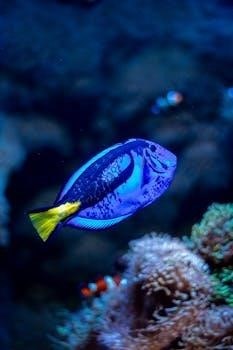rumble fish pdf
- by leo

Rumble Fish, a compelling novel by S.E. Hinton, delves into the turbulent life of a young protagonist navigating gang culture and familial challenges. The story is set against a backdrop of social and personal turmoil, portraying a gritty and impoverished town.
Author S.E. Hinton’s Background
S.E. Hinton, also known as Susan Eloise Hinton, is an acclaimed American author renowned for her young adult novels. Born in Tulsa, Oklahoma, her experiences growing up in a similar environment heavily influenced her writing. Hinton’s early works, such as “The Outsiders,” established her as a voice for troubled youth, exploring themes of identity, belonging, and social class. She often writes about the less-than-perfect teenage life, depicting characters facing broken homes and neighborhoods. Hinton’s writing style is characterized by its realism and raw portrayal of adolescence. Her work often explores complex relationships, particularly between brothers, and tackles the issues of isolation and abandonment. Rumble Fish, published in 1975, is considered her third novel, continuing her exploration of these themes.
Plot Summary of Rumble Fish
Rumble Fish begins with Rusty-James, the narrator, meeting his old friend Steve after a long separation. This encounter prompts Rusty-James to reflect on his past, particularly his relationship with his older brother, the enigmatic Motorcycle Boy. The story unfolds in a series of flashbacks, depicting Rusty-James’s life as a young greaser involved in fights and his struggles to gain recognition. Key events include his expulsion from school, conflicts with rivals, and his fascination with the Motorcycle Boy. The narrative focuses on Rusty-James’s idolization of his brother and his attempts to emulate him. The climax involves the Motorcycle Boy’s return and his subsequent actions, including freeing the “rumble fish” from the pet store, which ultimately leads to his tragic demise. The novel explores the themes of identity, brotherhood, and the consequences of violence.

Characters in Rumble Fish
The story features Rusty-James, a young man grappling with his identity, and his idolized older brother, the Motorcycle Boy. These two central characters are surrounded by a cast of other complex figures;
Rusty-James’s Character Analysis
Rusty-James is the central figure in Rumble Fish, a young teen navigating a tough urban environment. He resides in a gritty neighborhood marked by gang activity, where survival is a constant struggle. His world is a mix of rough school days and turf wars. Rusty-James is driven by a desire to emulate his older brother, the Motorcycle Boy, a former gang leader. He resorts to fighting to feel good about himself, masking his insecurities. The story explores his journey, his relationships, and his struggle to find his own identity, separate from his brother’s shadow. Rusty-James narrates the tale, providing a personal and intimate perspective on his experiences. He grapples with the complexities of growing up in a broken home and neighborhood, adding layers of depth to his character.
The Motorcycle Boy’s Character Analysis
The Motorcycle Boy is a complex and enigmatic figure, a former gang leader and the older brother of Rusty-James. He is an object of intense admiration for Rusty, who sees him as a symbol of coolness and rebellion. The Motorcycle Boy is known for his detached demeanor and his fascination with the Siamese fighting fish, which he calls rumble fish. He is colorblind, which adds to his perception of the world as different from others. He is often seen as mysterious and aloof, making his actions unpredictable and his motivations unclear. He serves as a powerful influence on Rusty-James, who tries to emulate him, even though the Motorcycle Boy has moved past his gang life. He is a symbol of the desire to escape, a figure trying to find his place. His eventual demise has a profound effect on his younger brother.

Themes Explored in Rumble Fish
The novel explores themes of alienation, abandonment, and poverty. It examines the struggles of identity, the impact of gang culture, and the search for meaning in a harsh environment.
Symbolism of the Rumble Fish
The Siamese fighting fish, also known as “rumble fish,” serve as a powerful and central symbol within the narrative. These fish, with their aggressive nature and tendency to fight when placed together, mirror the struggles and conflicts experienced by the characters, particularly Rusty-James and his brother, the Motorcycle Boy. The fish are trapped in their environment, much like the characters are confined by their circumstances and the limitations of their world. The vibrant colors of the fish, which are noted as the only color in the film due to the Motorcycle Boy’s colorblindness, also symbolize a longing for something more vibrant and meaningful in their otherwise bleak existence. The fish’s constant fighting reflects the characters’ battles for survival, recognition, and meaning in a world that often feels devoid of hope. The fish therefore represent the characters’ trapped, fighting existence.
Exploration of Gang Culture
Rumble Fish provides a stark exploration of gang culture, depicting a world where violence and the struggle for survival are commonplace. The novel delves into the dynamics of these groups, highlighting the sense of belonging and identity they offer to young people like Rusty-James. The characters navigate a gritty environment marked by turf wars and constant challenges to their place within the social hierarchy; The book shows how the characters are deeply affected by their environment, facing constant struggles and fighting for recognition. The gang becomes a surrogate family for these characters, providing a sense of purpose and community in their otherwise fragmented lives, and shows the consequences of this lifestyle. The story reveals the complexities and dangers of this world, where loyalty and violence often blur together. The narrative does not shy away from the grim realities of this culture.
Themes of Isolation and Abandonment
Rumble Fish poignantly explores the themes of isolation and abandonment, central to the experiences of its characters. Rusty-James grapples with a profound sense of loneliness stemming from his fragmented family life, particularly the absence of his parents and the mysterious nature of his brother. This feeling of being alone is further amplified by the harsh realities of his environment, where connections are often fleeting and unreliable. The characters often feel disconnected from the world around them. The theme of abandonment is also evident in the lives of the other characters, reflecting a broader sense of displacement and detachment from society. They are forced to rely on each other, forming bonds of brotherhood in their isolated existence. Their struggles emphasize the profound impact of these feelings on their development and choices. The story highlights the destructive effects of isolation.

Rumble Fish⁚ Film Adaptation
The novel was adapted into a film in 1983, directed by Francis Ford Coppola. The movie captures the story’s intense emotions and visual style. It is a stylistic and memorable adaptation.
Francis Ford Coppola’s Film Direction
Francis Ford Coppola’s direction of the Rumble Fish film is marked by a distinctive and stylized approach, enhancing the narrative’s themes through visual storytelling. His use of black and white cinematography, punctuated by the vibrant colors of the Siamese fighting fish, creates a dreamlike atmosphere, reflecting the characters’ distorted perceptions. The film employs expressionistic techniques, utilizing dramatic camera angles and stark lighting to amplify the emotional intensity of the story. Coppola’s direction emphasizes the themes of isolation and disillusionment, mirroring the protagonist’s fractured world. The film’s unique aesthetic, combined with its deliberate pacing and focus on character development, underscores the director’s innovative approach to adapting Hinton’s novel. Coppola also incorporates unconventional editing and sound design, creating a surreal and captivating viewing experience. His bold choices cement the film as a memorable and artistic interpretation of the source material.

Critical Analysis and Reception
Rumble Fish has garnered significant critical attention for its exploration of complex themes and its unique narrative style. The novel and film adaptation are studied for their artistic value and cultural impact.
Critical Overview of the Novel
S.E. Hinton’s Rumble Fish is often lauded for its raw and unflinching portrayal of teenage life, particularly within a marginalized community. Critics have noted Hinton’s ability to capture the complexities of adolescence, including themes of identity, loyalty, and the search for meaning. The novel stands out for its use of a first-person narrative, allowing readers to delve into the psyche of Rusty-James, the troubled protagonist. The book is also praised for its symbolic use of the Siamese fighting fish, or “rumble fish,” which serves as a metaphor for the characters’ internal conflicts and struggles. Furthermore, the novel is recognized for its exploration of the impact of absent or ineffective parenting on young people, highlighting the cycle of violence and desperation. The exploration of brotherhood and the pressure to live up to an idealized image of a sibling are also discussed by critics. Many see it as a powerful examination of troubled youth.
Significance of the Novel and Movie
Rumble Fish, both as a novel and film, holds significant cultural weight for its exploration of challenging themes and its artistic merit. The novel is notable for its unflinching portrayal of troubled youth and the destructive nature of gang culture, offering readers a glimpse into a world often overlooked. Its lasting impact can be seen in its continuing relevance to discussions of adolescence and societal issues. The subsequent film adaptation, directed by Francis Ford Coppola, amplified the novel’s themes, using striking visual elements and a unique black-and-white aesthetic to convey the characters’ alienation and internal struggles. The movie further solidified the story’s place in popular culture, introducing it to a wider audience and sparking critical dialogue about its artistic choices and representation of youth. The combination of the novel’s literary merit and the film’s artistic vision has cemented Rumble Fish’s place in American culture as a powerful and enduring story.
Related posts:
Unleash the raw power of S.E. Hinton’s ‘Rumble Fish’ in a convenient PDF! Get your copy now and experience the story’s grit and emotion. Download the Rumble Fish PDF today!
Posted in PDF